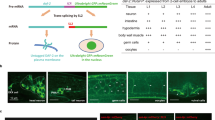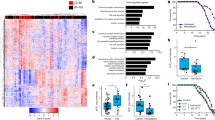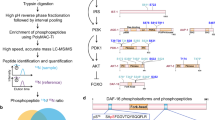Abstract
Dietary restriction extends lifespan and retards age-related disease in many species and profoundly alters endocrine function in mammals. However, no causal role of any hormonal signal in diet-restricted longevity has been demonstrated. Here we show that increased longevity of diet-restricted Caenorhabditis elegans requires the transcription factor gene skn-1 acting in the ASIs, a pair of neurons in the head. Dietary restriction activates skn-1 in these two neurons, which signals peripheral tissues to increase metabolic activity. These findings demonstrate that increased lifespan in a diet-restricted metazoan depends on cell non-autonomous signalling from central neuronal cells to non-neuronal body tissues, and suggest that the ASI neurons mediate diet-restriction-induced longevity by an endocrine mechanism.
This is a preview of subscription content, access via your institution
Access options
Subscribe to this journal
Receive 51 print issues and online access
$199.00 per year
only $3.90 per issue
Buy this article
- Purchase on Springer Link
- Instant access to full article PDF
Prices may be subject to local taxes which are calculated during checkout





Similar content being viewed by others
References
Koubova, J. & Guarente, L. How does calorie restriction work? Genes Dev. 17, 313–321 (2003)
Mobbs, C. V. et al. Neuroendocrine and pharmacological manipulations to assess how caloric restriction increases life span. J. Gerontol. A Biol. Sci. Med. Sci. 56 (Spec No 1). 34–44 (2001)
de Cabo, R. et al. An in vitro model of caloric restriction. Exp. Gerontol. 38, 631–639 (2003)
Bartke, A. et al. Extending the lifespan of long-lived mice. Nature 414, 412 (2001)
Walker, G., Houthoofd, K., Vanfleteren, J. R. & Gems, D. Dietary restriction in C. elegans: from rate-of-living effects to nutrient sensing pathways. Mech. Ageing Dev. 126, 929–937 (2005)
Lakowski, B. & Hekimi, S. The genetics of caloric restriction in Caenorhabditis elegans. Proc. Natl Acad. Sci. USA 95, 13091–13096 (1998)
Houthoofd, K., Braeckman, B. P., Johnson, T. E. & Vanfleteren, J. R. Life extension via dietary restriction is independent of the Ins/IGF-1 signalling pathway in Caenorhabditis elegans. Exp. Gerontol. 38, 947–954 (2003)
Kenyon, C. The plasticity of aging: insights from long-lived mutants. Cell 120, 449–460 (2005)
Bowerman, B., Eaton, B. A. & Priess, J. R. skn-1, a maternally expressed gene required to specify the fate of ventral blastomeres in the early C. elegans embryo. Cell 68, 1061–1075 (1992)
An, J. H. & Blackwell, T. K. SKN-1 links C. elegans mesendodermal specification to a conserved oxidative stress response. Genes Dev. 17, 1882–1893 (2003)
Golden, T. R., Hinerfeld, D. A. & Melov, S. Oxidative stress and aging: beyond correlation. Aging Cell 1, 117–123 (2002)
Zhenyu, Y., Jin, S., Yang, C., Levine, A. J. & Heintz, N. Beclin 1, an autophagy gene essential for early embryonic development, is a haploinsufficient tumor suppressor. Proc. Natl Acad. Sci. USA 100, 15077–15082 (2003)
Wilson, M. A. et al. Blueberry polyphenols increase lifespan and thermotolerance in Caenorhabditis elegans. Aging Cell 5, 59–68 (2006)
Bargmann, C. I. & Horvitz, H. R. Control of larval development by chemosensory neurons in Caenorhabditis elegans. Science 251, 1243–1246 (1991)
Jansen, G. et al. The complete family of genes encoding G proteins of Caenorhabditis elegans. Nature Genet. 21, 414–419 (1999)
Libina, N., Berman, J. R. & Kenyon, C. Tissue-specific activities of C. elegans DAF-16 in the regulation of lifespan. Cell 115, 489–502 (2003)
Alcedo, J. & Kenyon, C. Regulation of C. elegans longevity by specific gustatory and olfactory neurons. Neuron 41, 45–55 (2004)
Lin, S. J. et al. Calorie restriction extends Saccharomyces cerevisiae lifespan by increasing respiration. Nature 418, 344–348 (2002)
Houthoofd, K. et al. Axenic growth up-regulates mass-specific metabolic rate, stress resistance, and extends life span in Caenorhabditis elegans. Exp. Gerontol. 37, 1371–1378 (2002)
Houthoofd, K. et al. No reduction of metabolic rate in food restricted Caenorhabditis elegans. Exp. Gerontol. 37, 1359–1369 (2002)
Bargmann, C. I. & Horvitz, H. R. Chemosensory neurons with overlapping functions direct chemotaxis to multiple chemicals in C. elegans. Neuron 7, 729–742 (1991)
Dowell, P., Hu, Z. & Lane, M. D. Monitoring energy balance: metabolites of fatty acid synthesis as hypothalamic sensors. Annu. Rev. Biochem. 74, 515–534 (2005)
Li, C. The ever-expanding neuropeptide gene families in the nematode Caenorhabditis elegans. Parasitology 131 (Suppl.). S109–S127 (2005)
Ren, P. et al. Control of C. elegans larval development by neuronal expression of a TGF-β homolog. Science 274, 1389–1391 (1996)
Brenner, S. The genetics of Caenorhabditis elegans. Genetics 77, 71–94 (1974)
Avery, L. & Horvitz, H. R. Pharyngeal pumping continues after laser killing of the pharyngeal nervous system of C. elegans. Neuron 3, 473–485 (1989)
Peckol, E. L., Zallen, J. A., Yarrow, J. C. & Bargmann, C. I. Sensory activity affects sensory axon development in C. elegans. Development 126, 1891–1902 (1999)
Braeckman, B. P., Houthoofd, K. & Vanfleteren, J. R. Assessing metabolic activity in aging Caenorhabditis elegans: concepts and controversies. Aging Cell 1, 82–88 (2002)
Timmons, L., Court, D. L. & Fire, A. Ingestion of bacterially expressed dsRNAs can produce specific and potent genetic interference in Caenorhabditis elegans. Gene 263, 103–112 (2001)
Wang, D. et al. Somatic misexpression of germline P granules and enhanced RNA interference in retinoblastoma pathway mutants. Nature 436, 593–597 (2005)
Apfeld, J. & Kenyon, C. Regulation of lifespan by sensory perception in Caenorhabditis elegans. Nature 402, 804–809 (1999)
Mello, C. C., Kramer, J. M., Stinchcomb, D. & Ambros, V. Efficient gene transfer in C. elegans: extrachromosomal maintenance and integration of transforming sequences. EMBO J. 10, 3959–3970 (1991)
Kim, K., Colosimo, M. E., Yeung, H. & Sengupta, P. The UNC-3 Olf/EBF protein represses alternate neuronal programs to specify chemosensory neuron identity. Dev. Biol. 286, 136–148 (2005)
Jin, Y. in C. elegans: A Practical Approach (ed. Hope, I. A.) 69–96 (Oxford University Press, New York, 1999)
Lawless, J. F. Statistical Models and Methods for Lifetime Data (Wiley, New York, 1982)
Kamath, R. S. et al. Systematic functional analysis of the Caenorhabditis elegans genome using RNAi. Nature 421, 231–237 (2003)
McKay, R. M., McKay, J. P., Avery, L. & Graff, J. M. C elegans: a model for exploring the genetics of fat storage. Dev. Cell 4, 131–142 (2003)
Acknowledgements
We thank H. R. Horvitz for allowing use of essential equipment, and members of the Guarente and Horvitz laboratories for advice and discussions. We thank D. Kim and F. Ausubel for the gift of an unpublished strain. Many of the strains used in this work were provided by the Caenorhabditis Genetics Center. This work was supported by a grant from the National Institutes of Health.
Author information
Authors and Affiliations
Corresponding author
Ethics declarations
Competing interests
L.G. is a founder of Elixir Pharmaceuticals.
Supplementary information
Supplementary Information
This file contains Supplementary Figures S1 – S7, Supplementary Tables S1 – S2 and additional references. (PDF 2104 kb)
Rights and permissions
About this article
Cite this article
Bishop, N., Guarente, L. Two neurons mediate diet-restriction-induced longevity in C. elegans. Nature 447, 545–549 (2007). https://doi.org/10.1038/nature05904
Received:
Accepted:
Issue Date:
DOI: https://doi.org/10.1038/nature05904
This article is cited by
-
The metabolite alpha-ketobutyrate extends lifespan by promoting peroxisomal function in C. elegans
Nature Communications (2023)
-
A new AMPK isoform mediates glucose-restriction induced longevity non-cell autonomously by promoting membrane fluidity
Nature Communications (2023)
-
Endogenous DAF-16 spatiotemporal activity quantitatively predicts lifespan extension induced by dietary restriction
Communications Biology (2023)
-
Olfactory chemosensation extends lifespan through TGF-β signaling and UPR activation
Nature Aging (2023)
-
The metabolic contribution of SKN-1/Nrf2 to the lifespan of Caenorhabditis elegans
Metabolomics (2023)
Comments
By submitting a comment you agree to abide by our Terms and Community Guidelines. If you find something abusive or that does not comply with our terms or guidelines please flag it as inappropriate.



